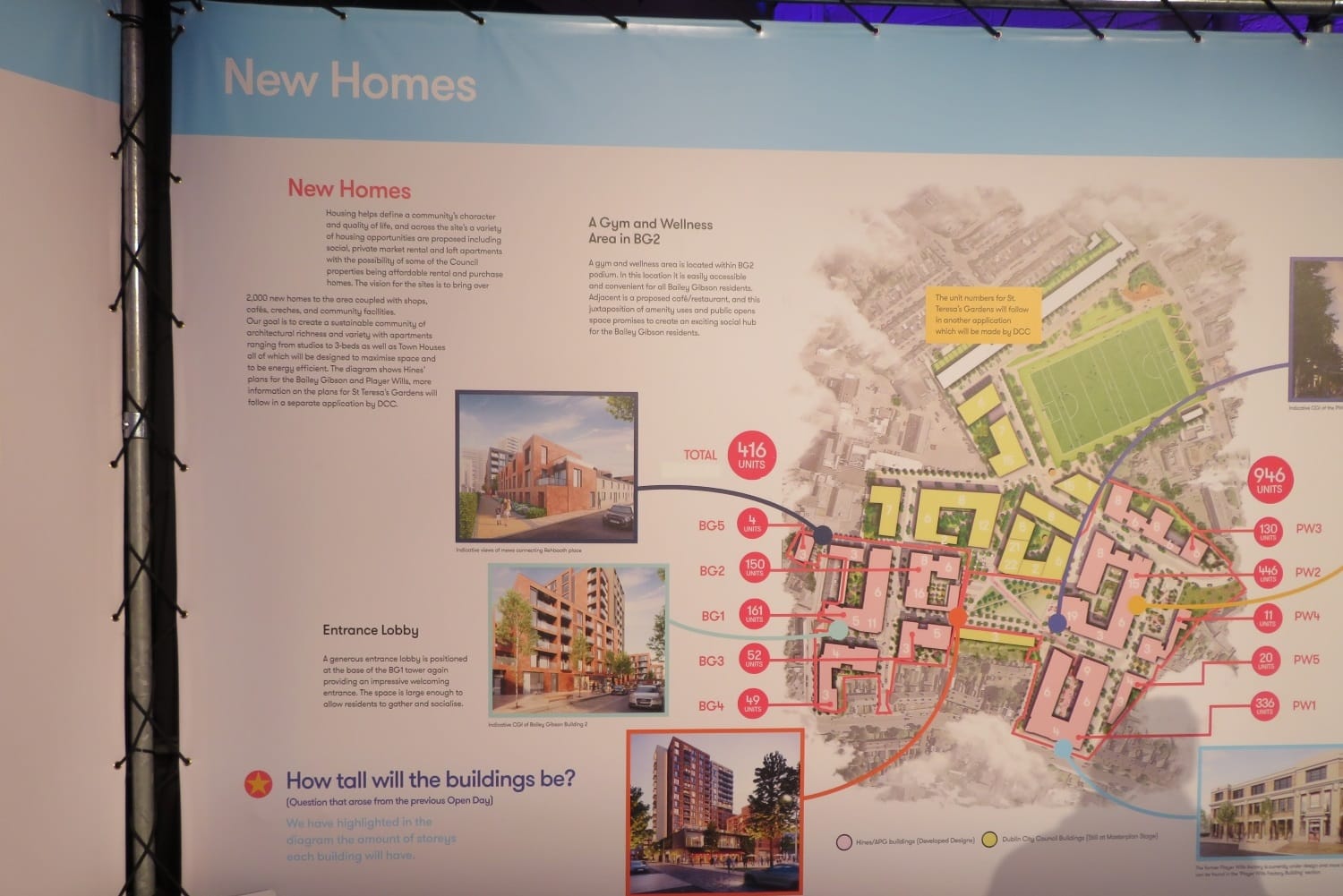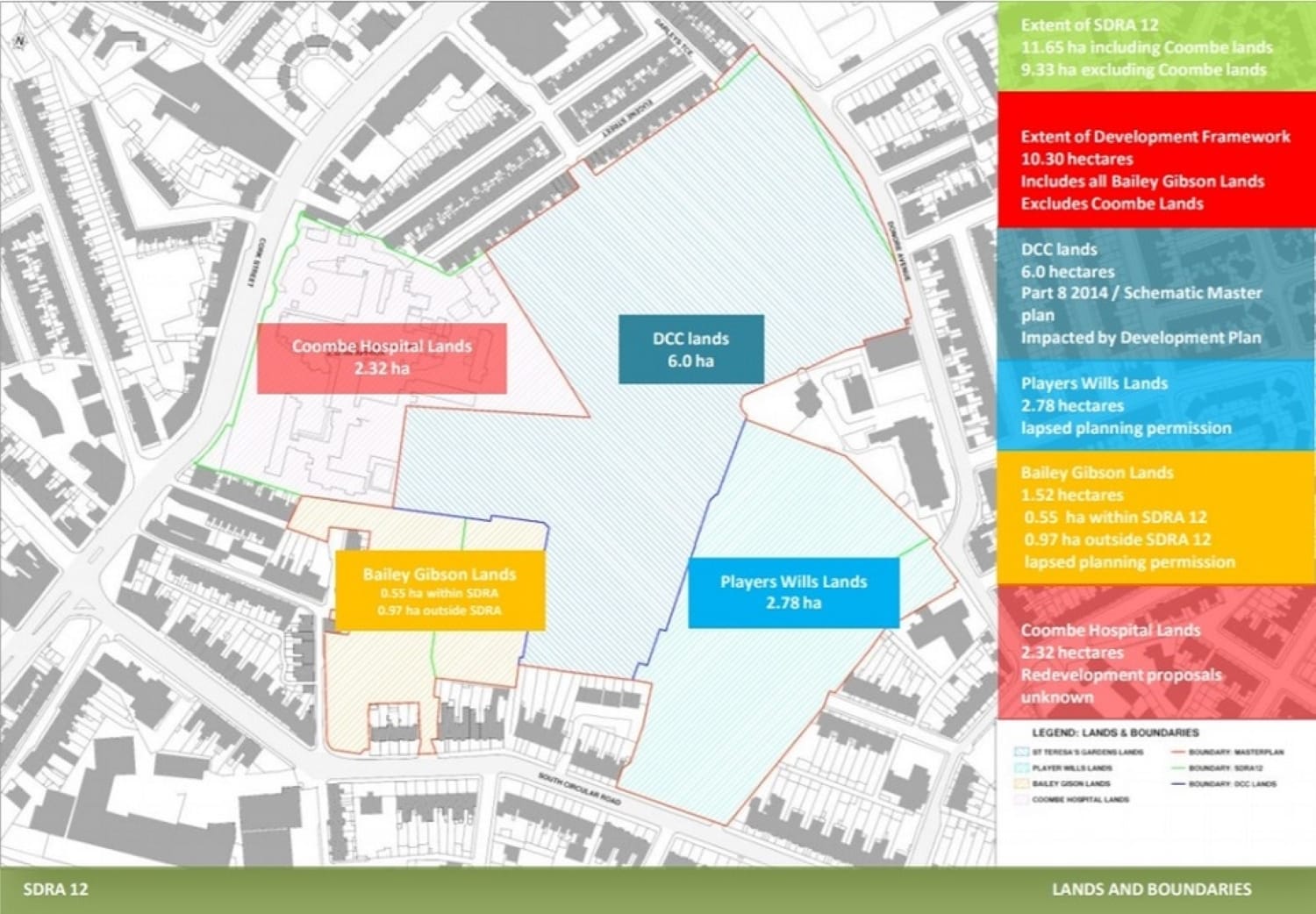In Ballymun, lining up to read and reconnect with the constitution
“Some people have said it's a bit like karaoke.”
Councillors welcomed plans to build on long-vacant land but also have concerns about rents – which estimates suggest will be between €1,350 for a studio and €2,800 a month for a three-bed.

In the Coombe last Thursday, the developer Hines unveiled designs and more details for around 1,400 luxury apartments, on lands including the old Player Wills cigarette factory and the adjoining Bailey Gibson site.
Dublin City Council plans to provide around 600 more homes, a park and a sports pitch on adjoining land it owns as part of an agreed masterplan, according to the plans. So, that’s about 2,000 new homes.
Hines plans to restore the Player Wills factory building to provide shared amenities, including a gym, cinema rooms and co-working spaces, as well as cultural space and artists’ studios, according to the designs pasted up at a public open day in a warehouse on the site.
The development boasts barbecue areas, dining rooms, shops, restaurants, parking and laundry facilities, the designs showed.
“I’m positive towards it. It’s an improvement,” said local resident Ann Canning, staring up at the gigantic screens displaying information, diagrams and artists’ impressions of the new complex.
But “none of it will be sold, they’re all for rent”, she says. “That is a great shame.”
Local councillors welcomed the move to address the vacancy and dereliction across a swathe of the neighbourhood, but also expressed concern about the high rents – which estimates from the developer suggest will be between €1,350 for a studio and €2,800 a month for a three-bed.
The planned developments would start low on some edges, with three-storey townhouses beside the existing two-storey houses on one street. The buildings get higher in stages – topping out at 22 storeys in the middle.
Hines’ tallest building would be 19 storeys, while outline plans for council’s lands indicate buildings as tall as 22 storeys in the middle of the development.
The entire complex on the Hines-owned land is build-to-rent. Besides meaning that there are no homes to buy, it also means the apartments are built to lower specifications, says Labour Councillor Rebecca Moynihan. In particular, they can be smaller.
A Hines spokesperson said that the plan is for around 60 percent of the homes to be one-bedroom apartments, 20 percent to 25 percent to be two-bedroom apartments, approximately 10 percent or 15 percent to be studios, and 5 percent to be three-bedroom townhouses.
Gary Corrigan, managing director with Hines, said that studios would be 37sqm, one-beds would be 45sqm, two-bedroom apartments would be 74sqm, and three-bedroom townhouses would be 90sqm, they said.

A spokesperson for Hines pointed to research drawn together by economist Ronan Lyons for Irish Institutional Property, a lobby group for institutional investors, which highlights demand from one and two-person households.
Because there are a lot of single people living in shared houses, “we do need more one-bed units”, says Moynihan, the Labour councillor. But this development won’t address that need if it is not affordable for those people, she says.
Says Sinn Féin Councillor Críona Ní Dhálaigh: “We really need family accommodation. My fear is that that is not what is going to be delivered.”
A build-to-rent development where the majority of homes are studios and one-beds won’t create a sustainable community because once people have children they will need to move on, she says.
If the homes aren’t creating stable communities then they go against the vision for the city laid down by councillors in the city development plan, she says.

For the Dublin City Council land, which sits between two of the Hines plots, that must be used for affordable housing, Ní Dhálaigh says.
“That is public land and it has to be public housing,” she says. “It is up to us to ensure that some of it is cost-rental and the rest is social.”
“We are unique currently in Dublin with the level of amenities and community space,” says Corrigan, managing director with Hines.
He highlights that the development is to be dog-friendly, with ample outdoor space for dog walking and even dog-washing facilities.
As well as a gym, shops, restaurants and lounges, there are to be communal dining rooms that residents can book so that if they are living in a small apartment and want to have a dinner party, they can do so, he says.
A cleaning service will be available at an extra cost and maintenance personnel will be based on-site, he says.
All the homes have balconies and there will be roof gardens and other communal outside space, he says.
Corrigan talks with enthusiasm about the restoration of the Player Wills factory. “The factory is the heart of it,” he says.
As well as the gym and workspaces for the residents, the factory includes artists’ studios, community and creative space, and a sculpture garden.
“I’m happy that the building is being retained,” says Moynihan, the Labour councillor. “I still want it added to the [Record of] Protected Structures.”
Hines are including cultural spaces in their side of the development, but that is not enough, says Moynihan.
It doesn’t compare with Dublin City Council’s contribution to providing communal space that will be used by all the residents, she says.
“The services to match the development aren’t there,” she says. “The parks, green spaces and pitch are all on city council land.”
Ten percent of the homes in the Hines part of the development will be social housing, in line with legislation, but other than that the entire development is to be build-to-rent, says a spokesperson for Hines.
It is currently envisaged that the studios will cost around €1,350 per month, one-beds should rent for €1,800 per month, two-beds for €2,250 per month and three-beds for €2,800 per month, they said.
Those prices include free wifi, free access to the gym and use of lounges as well as dining rooms, says Corrigan.
“It’s completely outside of the ordinary people’s price range,” says Ní Dhálaigh, the Sinn Féin councillor. “Who are they building them for?”
“It is great that the dereliction is being addressed,” she says. “But there was so much opportunity here to deliver for the entire community, a chance to develop a whole new village.”
“There is the question of affordability,” says Moynihan, of Labour. “Luxury accommodation units are already lying empty.”
Last year, a paper from the Department of Finance found that while ownership by large investors in the rental market was still limited, some localities had a higher-than-average proportion of ownership by professional landlords.
“Ownership shares in the rental market beyond a certain level in any particular locality may bestow rent-setting power to an individual or group of firms,” the paper said – while noting that it was beyond the scope of the paper to work out if that was the case anywhere at the time.
In the Dáil, Eoghan Murphy, the Fine Gael housing minister, said that in the main, the report said the activities of such firms were a positive development, and that currently there are a diverse range of landlords.
At the open day last week, Canning, the local resident, said she doesn’t think the Hines prices sound affordable for most people. But she has seen similar priced rentals – of not a great standard – in the area, she said.
On 17 March, one 22 sqm studio not far away was listed on Daft.ie for €1,300 a month by property managers Grayling Properties – a subsidiary of Lugus Capital Advisors and linked to Belgrave Property Management which has been giving tenants notices to quit, renovating properties and raising rents, around Grove Park, Rathmines, and Portobello.
Canning says she would like to see some homes available for people to buy but she doesn’t blame Hines for pursuing the build-to-rent model.
Rather, “the government needs to step in and introduce measures to stop entire developments being for rent”, she says.